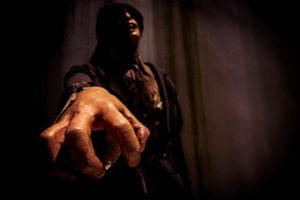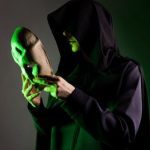 Creepy
Creepy  Creepy
Creepy  Technology
Technology 10 Scientific Breakthroughs of 2025 That’ll Change Everything
 Our World
Our World 10 Ways Icelandic Culture Makes Other Countries Look Boring
 Misconceptions
Misconceptions 10 Common Misconceptions About the Victorian Era
 Mysteries
Mysteries 10 Strange Unexplained Mysteries of 2025
 Miscellaneous
Miscellaneous 10 of History’s Most Bell-Ringing Finishing Moves
 History
History 10 Great Escapes That Ended Right Back in Captivity
 Weird Stuff
Weird Stuff 10 Fascinating Things You Might Not Know About Spiders
 Food
Food 10 Everyday Foods You Didn’t Know Were Invented by the U.S. Military
 History
History 10 Odd Things Colonial Americans Kept at Home
 Creepy
Creepy 10 More Representations of Death from Myth, Legend, and Folktale
 Technology
Technology 10 Scientific Breakthroughs of 2025 That’ll Change Everything
 Our World
Our World 10 Ways Icelandic Culture Makes Other Countries Look Boring
Who's Behind Listverse?

Jamie Frater
Head Editor
Jamie founded Listverse due to an insatiable desire to share fascinating, obscure, and bizarre facts. He has been a guest speaker on numerous national radio and television stations and is a five time published author.
More About Us Misconceptions
Misconceptions 10 Common Misconceptions About the Victorian Era
 Mysteries
Mysteries 10 Strange Unexplained Mysteries of 2025
 Miscellaneous
Miscellaneous 10 of History’s Most Bell-Ringing Finishing Moves
 History
History 10 Great Escapes That Ended Right Back in Captivity
 Weird Stuff
Weird Stuff 10 Fascinating Things You Might Not Know About Spiders
 Food
Food 10 Everyday Foods You Didn’t Know Were Invented by the U.S. Military
 History
History 10 Odd Things Colonial Americans Kept at Home
10 Truly Evil People Who Used Halloween as the Perfect Cover
Halloween uniquely complicates the concept of safety because the night is defined by intentional fear, masking genuine threat within theatrical play. This widespread acceptance of costumes and chaotic activity gives real criminals an immediate advantage, allowing them to commit malicious acts with a much lower risk of immediate detection. The psychological impact of a Halloween crime is profound, as it turns an innocent tradition into a horrifying violation of community trust, as seen in the notorious Ronald Clark O’Bryan case.
Over time, real-life incidents like these have helped fuel Halloween’s most persistent urban legends—from poisoned candy to masked killers lurking behind plastic smiles. This list examines ten true-crime incidents across various decades, profiling a range of motives—from calculated financial schemes to acts of opportunity and extreme violence—all set on or around October 31. Ultimately, these documented tragedies force us to look past the festive masks and confront the disturbing reality that, for some, the year’s spookiest night was when true evil appeared.
Related: Top 10 Creepiest Things People Have Done to Kids’ Halloween Candy
10 The Van Nuys Party Killer

On October 29, 1967, an altercation turned deadly at a Halloween costume party held at the Valley Country Club Apartments in Van Nuys, California. Jack Gentry Stearns shot and killed fellow party guest Kenneth A. Lindstrand in a fit of jealousy after seeing Lindstrand dancing with his wife. The sheer shock of the event was compounded by the holiday context, as witnesses initially thought the gunshot was an elaborate Halloween skit or prank.
In the chaotic moments immediately following the shooting, the presence of costumes and a festive atmosphere led many to dismiss the violence as a staged performance designed to heighten the night’s thrill. This tragic confusion underscores how blurring fantasy and reality on Halloween night can provide a dangerous cover for real-life crime. The initial assumption that the event was just a prank allowed the true horror to take a moment longer to register.
Stearns was later convicted of first-degree murder for the crime. The case became a chilling local example of how the unique elements of Halloween—costumes, crowds, and the expectation of frightening theatrics—can be tragically exploited or, as in this case, cause genuine violence to be mistaken for harmless play.[1]
9 The Kirkland Shopkeeper’s Unsolved End
On the night of Halloween in 1957, Norton Gregory, a 49-year-old shopkeeper in Kirkland, Washington, was found brutally murdered. Gregory, who ran a sporting goods store, was known to be working late that evening in preparation for a fishing-season rush. The crime occurred on or around the holiday, contributing to the unsettling atmosphere surrounding the unsolved case.
The murder remains one of the Puget Sound region’s most enduring and frustrating cold cases. Gregory was beaten and stabbed, but police never identified a killer. The proximity to Halloween has often been mentioned in retellings, as the presence of costumed and masked individuals in the community made it more difficult for witnesses to notice or remember anything suspicious.
The anonymity provided by Halloween masks and costumes in the small community may have offered the killer the perfect, momentary disguise to approach or escape undetected. Despite decades passing and continued public fascination, the murderer has never been caught, leaving the town to forever associate the friendly shopkeeper’s violent end with the spooky holiday.[2]
8 The Dastardly Dentist’s Murder Plot
On Halloween night in 1957, in Los Angeles, California, Dr. Peter Fabiano was murdered by a masked woman who appeared at his door, seemingly as a late trick-or-treater. This unexpected visit in the late hours of the night was actually a meticulously planned assassination. The woman raised a gun and shot Dr. Fabiano in the chest, killing him instantly.
The subsequent investigation revealed that the killer, Goldyne Pizer, had been persuaded to commit the murder by her lover, Joan Rabel, who was infatuated with Fabiano’s wife, Betty. The plot, a murder-for-hire fueled by jealousy, became one of the most shocking love-triangle crimes in Los Angeles history.
The killer’s use of a mask served as a perfect, easy disguise to approach the victim’s door without suspicion. On a night when masks are everywhere, the murderer was able to blend in, with the victim likely dropping his guard for what he assumed was a harmless late-night visitor.[3]
7 The Last Victim of the Tool Box Killers
The terrifying serial-killer duo, Lawrence Bittaker and Roy Norris—known as the Tool Box Killers—concluded their brutal crime spree on Halloween night, October 31, 1979. Their final victim, Shirley Lynette Ledford, was picked up in their van as she was leaving a Halloween party in Southern California.
Bittaker and Norris abducted Ledford and subjected her to horrific torture and sexual assault, some of which they recorded on a cassette tape. Ledford’s body was later found on a stranger’s lawn, marking the end of a reign of terror that spanned four months and claimed the lives of five teenage girls.
The chaotic and often masked atmosphere of a late-night Halloween party provided an easy environment for the predators to scout for and abduct a victim. People out on the streets late, dressed in costume and distracted, were less likely to be noticed or remembered by witnesses—allowing the killers to operate with frightening freedom.[4]
6 The “Sweet” Poisoner of Utah

While this case has a connection to the Halloween season rather than the night itself, it involves a man named Paul Warner who mailed poisoned candy to his wife and daughter in 2000. He attempted to disguise the crime as a Halloween candy-tampering incident, a fear that has plagued the holiday since the 1970s.
Warner had laced a box of chocolates with cyanide and tried to kill his family to collect on a life-insurance policy. When his wife, who had eaten some, became violently ill but survived, he claimed the candy must have been poisoned by a stranger’s act of Halloween malice, exploiting a long-standing urban legend.
Although his crime did not occur on October 31, Warner’s motive was to use the widespread fear of poisoned Halloween candy as the cover story for his attempted murders, hoping to mislead investigators and avoid suspicion. His plan failed, and he was convicted of attempted murder and aggravated assault.[5]
5 The Death of Martha Moxley
Martha Moxley, a 15-year-old girl, was found beaten to death with a golf club on the morning of October 31, 1975, in Greenwich, Connecticut. The murder is believed to have occurred late on Halloween night after she had been out with friends. The location and timing pointed directly to the holiday’s events.
Moxley was last seen in the neighborhood of Belle Haven, attending a small Halloween gathering with friends, including the brothers Thomas and Michael Skakel, nephews of Senator Robert F. Kennedy. Her body was discovered beneath a tree in her family’s backyard, adding to the immediate, sinister atmosphere of the case.
The murder remained unsolved for decades, partially due to the difficulty in placing people and events on a night when many were out and masked. Michael Skakel was eventually convicted of the murder in 2002, though the conviction was later vacated in 2013 and charges dismissed in 2020. The Halloween timing added a dark layer of intrigue to the high-profile, complex case.[6]
4 The North Dakota Halloween Homicide
On Halloween night, October 31, 2007, 20-year-old Joel Lovelien was fatally assaulted outside a Halloween party in Grand Forks, North Dakota. The extreme violence of the attack, which caused him to choke on his own blood, was initially confused in the chaotic party setting.
The killer, Drew Peterson (no relation to the infamous police officer), was reportedly wearing a white mask, black shirt, and red gloves—a costume that allowed him to blend into the party crowd and later escape unnoticed. This use of disguise was crucial in the immediate aftermath, as the perpetrator disappeared quickly.
Peterson was convicted of murder. The combination of alcohol, a crowd of people, and the presence of masks and costumes allowed the perpetrator to commit a brutal, unprovoked crime and use the holiday atmosphere for anonymity. The sheer brutality of the attack, which fractured Lovelien’s facial bones, was discovered by the coroner during the autopsy.[7]
3 The Killer Clown Who Came Too Early
On the morning of May 26, 1990—months before Halloween—a killer dressed as a clown showed up at the home of 40-year-old Marlene Warren in Wellington, Florida. The clown carried flowers and two balloons, one reading “You’re the Greatest!” When Marlene opened her front door, the clown handed her the gifts and then pulled a revolver, shooting her once in the face before calmly walking away and driving off in a white Chrysler LeBaron.
The shocking crime remained unsolved for nearly three decades, becoming one of America’s most infamous “killer clown” cases. In 2017, advances in DNA and witness testimony led to the arrest of Sheila Keen Warren, who had since married Marlene’s widower, Michael Warren. In 2024, she pleaded guilty to second-degree murder and was sentenced to life in prison.
Although the murder did not take place on Halloween, its eerie mimicry of the holiday’s most iconic image—the masked clown—cemented its place among America’s most chilling true-crime stories. The sight of a costumed figure turning deadly would later fuel nationwide fears about “killer clowns,” blurring the line between Halloween fantasy and real-world horror.[8]
2 The Chinatown Home Invasion

On Halloween night in 1974, in Chinatown, Los Angeles, an 81-year-old man named Pok Suey Low was shot to death during a robbery attempt. His wife, who was 71 and nearly blind, answered the door to “trick-or-treaters,” only to find herself facing masked gunmen.
The invaders were wearing Wolf Man and Frankenstein masks. They forced their way into the house, but when Mr. Low emerged from the bedroom, one of the intruders shot him in the chest. The killers fled empty-handed, leaving behind their masks and a bag of candy, which suggested they had indeed been trick-or-treating earlier.
This event is a stark example of criminals using common, frightening Halloween masks to gain access to a home under the guise of the holiday tradition. The masks were even left behind at the scene, along with fingerprints, which were crucial to the subsequent investigation.[9]
1 The Man Who Killed Halloween
Ronald Clark O’Bryan, infamously nicknamed “The Candyman” and “The Man Who Killed Halloween,” murdered his 8-year-old son, Timothy O’Bryan, on Halloween night, October 31, 1974, in Deer Park, Texas. He used the cover of trick-or-treating to carry out his monstrous plot.
Heavily in debt, O’Bryan poisoned his son with potassium-cyanide-laced Pixy Stix to collect a life-insurance policy. He also gave poisoned candy to four other children, including his daughter, in a calculated attempt to make the crime look like a random act of Halloween candy tampering by an unknown maniac.
The crime exploited the existing urban legend of poisoned Halloween candy, turning a parent’s worst fear into a horrifying reality. The poison quickly killed Timothy, and O’Bryan’s lie about receiving the candy from a mysterious house unraveled within days. O’Bryan was convicted of capital murder and executed in 1984.[10]








